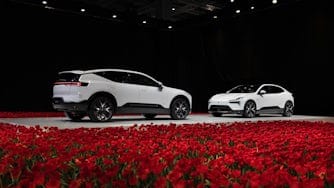Big car, smaller footprint – why the Polestar 3 is changing the way we look at SUVs
It comes as no surprise that SUVs are everywhere. As one of the world's highest-selling car models, there's lots to love about the versatile and practical Sports Utility Vehicle. From ferrying kids to soccer practice to scaling rocky off-road mountain passes in Central Asia, every location, destination, and occupation has a need for large, practical, and safe vehicles. But their popularity comes at a price. Because the world's favorite car type just so happens to be one of the world's biggest contributors to CO2e emissions.

That's why we decided to build the fun, luxurious, and performance-driven electric Polestar 3. And today - as we've done for all previous models - we're publishing its carbon footprint for all to see.
Energy hungry
"They drink too much," lamented Polestar CEO Thomas Ingenlath of the SUVs' insatiable appetite for fuel. It's hard not to ignore this simple truth. Bigger and heavier than other cars, the average SUV is responsible for 20 percent more CO2e per mile driven than other gas-fueled cars. That's a larger number than you think. With over 300 million SUVs on the road, the combined carbon emissions of those vehicles surpass that of most countries. In fact, only five nations produce more carbon dioxide than the one billion tons produced by the global fleet of SUVs. It comes as no surprise that the SUV is thought of as a car that comes with considerable baggage.
But does it need to be this way?


SUVs are a major contributor to greenhouse gas emissions, so it's important that electric alternatives are available to customers
Polestar 3 Life Cycle Assessment
Since launching last year, the Polestar 3 has offered an imaginative take on luxury travel for people who demand a little more space from their vehicles. Making use of creative aerodynamics and a unique design architecture, the fun and sporty SUV provides all the comfort and spaciousness expected from a larger car model but crucially does so while limiting its environmental impact.
The numbers speak for themselves. A cradle-to-gate carbon footprint of 24.7 tCO2e means the Polestar 3 has a smaller footprint than the Polestar 2 at the time of its launch in 2020. With 81 percent of the vehicle's total aluminum mass production, Li-ion battery cell module production, and anode and cathode material production using 100 percent renewable electricity, it's a car that has taken all the manufacturing knowledge and learnings from four years of Polestar 2 production and improved on it.
But there's more to do. As we remain one of the few car manufacturers committed to publishing LCA reports for our entire line-up, we're encouraging fact-based decision-making not only for customers but also for suppliers, partners, competitors, and the rest of our friends in the automotive industry.
"SUVs are a major contributor to greenhouse gas emissions, so it's important that electric alternatives are available to customers. There is still a lot of work ahead to get where we want to be, but we're happy we've been able to take action to reduce Polestar 3's carbon footprint, focusing on renewable energy for aluminum and battery production. Polestar 3 also marks the first time a third party has reviewed our LCA report, which we feel further strengthens the validity of both the results and methodology used," says Fredrika Klarén, Head of Sustainability at Polestar.
So, here's to the Polestar 3, an SUV with the right type of baggage (and the boot space to accommodate it).
Order yours today.


